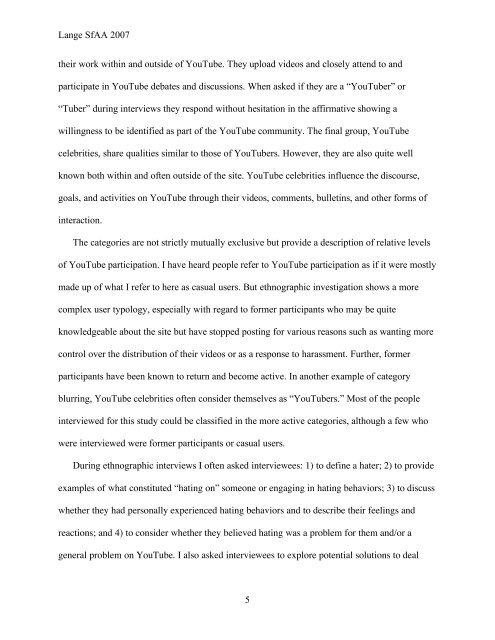Commenting on Comments: Investigating Responses to Antagonism ...
Commenting on Comments: Investigating Responses to Antagonism ...
Commenting on Comments: Investigating Responses to Antagonism ...
You also want an ePaper? Increase the reach of your titles
YUMPU automatically turns print PDFs into web optimized ePapers that Google loves.
Lange SfAA 2007<br />
their work within and outside of YouTube. They upload videos and closely attend <strong>to</strong> and<br />
participate in YouTube debates and discussi<strong>on</strong>s. When asked if they are a “YouTuber” or<br />
“Tuber” during interviews they resp<strong>on</strong>d without hesitati<strong>on</strong> in the affirmative showing a<br />
willingness <strong>to</strong> be identified as part of the YouTube community. The final group, YouTube<br />
celebrities, share qualities similar <strong>to</strong> those of YouTubers. However, they are also quite well<br />
known both within and often outside of the site. YouTube celebrities influence the discourse,<br />
goals, and activities <strong>on</strong> YouTube through their videos, comments, bulletins, and other forms of<br />
interacti<strong>on</strong>.<br />
The categories are not strictly mutually exclusive but provide a descripti<strong>on</strong> of relative levels<br />
of YouTube participati<strong>on</strong>. I have heard people refer <strong>to</strong> YouTube participati<strong>on</strong> as if it were mostly<br />
made up of what I refer <strong>to</strong> here as casual users. But ethnographic investigati<strong>on</strong> shows a more<br />
complex user typology, especially with regard <strong>to</strong> former participants who may be quite<br />
knowledgeable about the site but have s<strong>to</strong>pped posting for various reas<strong>on</strong>s such as wanting more<br />
c<strong>on</strong>trol over the distributi<strong>on</strong> of their videos or as a resp<strong>on</strong>se <strong>to</strong> harassment. Further, former<br />
participants have been known <strong>to</strong> return and become active. In another example of category<br />
blurring, YouTube celebrities often c<strong>on</strong>sider themselves as “YouTubers.” Most of the people<br />
interviewed for this study could be classified in the more active categories, although a few who<br />
were interviewed were former participants or casual users.<br />
During ethnographic interviews I often asked interviewees: 1) <strong>to</strong> define a hater; 2) <strong>to</strong> provide<br />
examples of what c<strong>on</strong>stituted “hating <strong>on</strong>” some<strong>on</strong>e or engaging in hating behaviors; 3) <strong>to</strong> discuss<br />
whether they had pers<strong>on</strong>ally experienced hating behaviors and <strong>to</strong> describe their feelings and<br />
reacti<strong>on</strong>s; and 4) <strong>to</strong> c<strong>on</strong>sider whether they believed hating was a problem for them and/or a<br />
general problem <strong>on</strong> YouTube. I also asked interviewees <strong>to</strong> explore potential soluti<strong>on</strong>s <strong>to</strong> deal<br />
5


